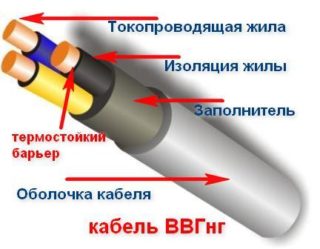The correct organization of the power supply of the dwelling provides for the calculation and installation of the input point. To ensure the safety of the line and the durability of its operation, the rules of the PUE should be observed. The introduction of electricity into the house can begin after the paperwork is completed and the measures are coordinated with the energy provider.
- Administrative and legal nuances
- Required documents
- Rules for connecting electricity to the house
- Correct connection options
- Choosing a cable to enter the house
- The specifics of using self-supporting insulated wire
- Fittings for fixing SIP-wire
- List of required materials
- Calculation of the cable cross-section for entering the house
- How is electricity input into the house by air
- Features of cable laying underground
- Ways to organize wiring inside the house
- Connecting different cables inside
- Connection of various conductors with fittings
- Through difavtomat
Administrative and legal nuances
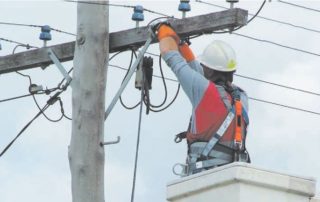
To introduce electricity into the premises, the owner must obtain permits from the power supply. The basis for the permit is the WPS project, where the internal power grid is described in detail, calculations of the power of consumers are provided. After that, the parameters of the allocated capacity and the consumer limit are set. According to the PVE, technical conditions are determined - a method of connection, features of communications, engineering aspects.
A house can be connected to electricity by RES teams, an owner or a contractor with a license.
Required documents
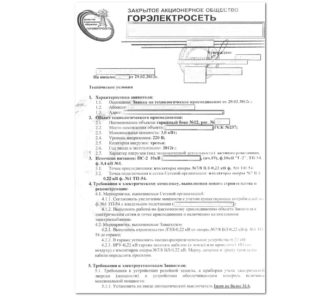
The property owner sends a request to the selected network organization. The company considers the application within 15 days. After a positive answer, documents are prepared:
- application for technical connection in a unified form;
- scheme of power receivers;
- copies of documents on the right to a building or land plot;
- application, which indicates the full name of the citizen, passport data, location of receivers, terms of project creation and commissioning of the line, provider name, permission for construction work.
After reviewing the documents, the energy provider sends a contract with technical conditions. The applicant only needs to sign it and send it to the representatives of the network organization.
If the site meets the requirements of the technical conditions, work on its territory is carried out at the expense of the owner. Activities outside the allotment are paid by the network company. Upon completion of the execution, the energy sales company connects the room to the network after a control examination.
Rules for connecting electricity to the house
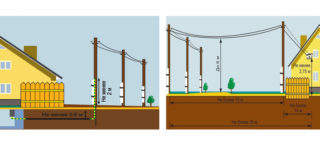
The power supply input device is subject to the requirements of the PUE and technical conditions. They indicate:
- location of connection points - 25 m from the border with neighbors;
- the distance of the cable from the power transmission line supports to the wall is 10 cm if a wooden house and 5 cm from brick surfaces;
- cable thickness for a single-phase line - 0.6 cm for copper conductors, 1.6 cm for aluminum conductors;
- the need to seal the introductory groove with non-combustible material;
- the location of the inlet is 2.75 m from the ground line and 1.5 m from the window;
- correspondence of the equipment power to the allocated power of 15 kW;
- the distance in a straight line from the power grid to which the plot adjoins - 300 m for the city and 500 m for the village.
Mandatory elements of the system are SIP wires, an electric meter, a shield, an intermediate metal support.
Correct connection options
The introduction of electricity into a private house can be done in two ways:
- Air is an inexpensive but noticeable option. The main part of the cable runs outdoors above the ground. The conductor can pass into the room in the pipe through the wall on the switchgear or meters. It is allowed to connect outside the house to a voltage stabilizer or meter;
- Underground - a hidden method when the wire is laid in an asbestos-cement pipe buried in the ground. The entrance to the building is through a technological hole in the foundation. From the power line to the entry point, the cable is laid along the pole.
For underground laying, use heavy duty wires.
Choosing a cable to enter the house
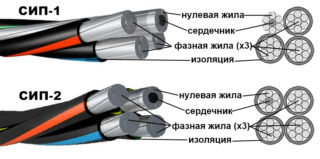
The optimal material for a home electrical network will be a SIP cable, which can be used to organize lines with voltages up to 35 kW. The wire consists of 3-phase cores, entwined with zero, has a high-quality insulating polyethylene coating. The neutral aluminum conductor is located in the center of the strand.
If a SIP cable is needed for wiring from the pole to the house through the air, you should pay attention to the insulating layer:
- thermoplastic polyethylene of insulation SIP-1, SIP-1A, SIP-4 and SIPn-4 can withstand temperatures up to +70 degrees;
- cross-linked polyethylene of materials SIP-2, SIP-2A, SIPs-4, SIP-3, PEV and PEVG withstands temperature loads up to 90 degrees, provides protection against overloads and short circuits.
A good underground cable has an insulating surface made of impregnated pressed paper, polyethylene, PVC. VBbShv or PvBShv conductors are reinforced with tape insulation. For areas with risk of damage, a PAKShp with a wire mesh is used.
The specifics of using self-supporting insulated wire

You can lead the SIP cable on a support or facade, making branches and other connections. When working with a wire, you must:
- pre-install the VLI supports, fixing the clamps on them;
- roll out by installing the rollers using a special belt or hooks. The wire is pulled to the extreme supports with a drum. Manually work as a cable leader;
- fix the electrical conductor to the supports. The supporting core is fixed with an anchor clamp;
- stretch the cable using a manual winch with a gripping amplifier;
- select a 2-core SIP-4 for a single-phase network, and a 4-core SIP-4 for a three-phase network.
The tension should be done smoothly, without distortions until the torque wrench head breaks off.
Fittings for fixing SIP-wire
The fittings for self-supporting insulated wire ensure a correct and high-quality process of transmitting electricity through the air. The structures must be made of moisture-resistant materials, suitable for the voltage of a single-phase or three-phase network. Replacement of products is allowed once every 20 years.
List of required materials

In electrical practice, the following types of fittings are used:
- Anchor brackets - 1 per house and power line support. Aluminum fixtures are not subject to corrosion, temperature fluctuations. Fixed with stainless steel banding straps.
- branch clamps - 4 (220 V) or 8 (380 V) pieces. Make contact when connecting cables with a cross section of 6-150 mm2 with conductors with a cross section of 1.5-6 mm2.
- Anchor clamps - 2 pcs. Elements provide fixation of wires with insulation on branches up to 1000 V. Internal wedges made of thermoplastic exclude damage to the insulating layer;
- intermediate clamps. With their help, you can connect SIP-4 to an intermediate or corner support. The material has a UV-resistant housing.
- Hooks. They are used to guide the conductor through the air on a wooden, metal support or wall surface.
You will also need a sleeve, a corrugated metal sleeve for bringing cables through the wall of the building.
Calculation of the cable cross-section for entering the house
PUE establish the use of a copper cable for networking. The standard also notes the dependence of the cross section on the line voltage and power parameters. In order not to engage in calculations, it is worth referring to the table.
| Automatic machine current, A | power, kWt | Cable section, mm2 | |
| 220 V network | 380 V network | ||
| 5 | 1,1 | 2,6 | 1 |
| 6 | 1,3 | 3,2 | 1 |
| 10 | 2,2 | 5,3 | 1,5 |
| 16 | 3,5 | 8,4 | 1,5 |
| 20 | 4,4 | 10,5 | 2,5 |
| 25 | 5,5 | 13,2 | 4 |
| 32 | 7 | 16,8 | 6 |
| 40 | 8,8 | 21,1 | 10 |
| 50 | 11 | 26,3 | 10 |
| 63 | 13,9 | 33,2 | 16 |
The suitable cross-section of the cable for entering the house is from 6 to 16 mm2. From the meter to the bus of switchgears of a single-phase network, a wire with a cross section of 6 mm2 is relevant.
On the street, an aluminum cable with a cross section of 10 mm2 is used, which does not oxidize. For laying in a wooden house, copper is advisable, which does not burn.
How is electricity input into the house by air
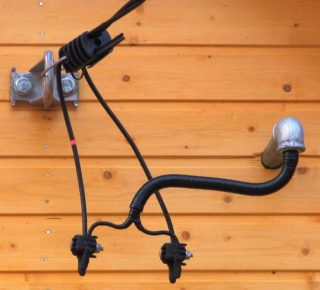
There are two ways to introduce a power line into a residential building by air:
- Through the walls. The conductor is located on the wall, fixed to it with insulated fasteners. For laying inside, a hole is organized through which a metal pipe with a plastic corrugation passes. The gap is filled with cement or asbestos.
- Through the lid. A metal pipe stand is used. The conductor is placed so that the distance from the roof level is more than 2 m. The structure is grounded.
When laying through the roof, a downward bend of the pipe is used, or a gander, in which wires for electricity are attached with ceramic insulators. In order to reduce the length of the cables, the wiring is carried out as close as possible to the distribution board.
Aerial technology is simple, so it is popular among home craftsmen. The disadvantage of this method is the risk of damage to the wires due to mechanical stress.
Features of cable laying underground
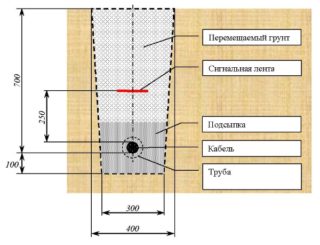
The electricity supply to a private house underground is carried out in a metal pipe. The length of the product corresponds to the length of the route, taking into account the turn. The underground method involves the use of copper conductors with a cross section of 4 mm2, if the line is removed by 10 m. If the distance is more than 10 m, a cable of 6 mm2 is used. Section of aluminum wire for a distance of up to 10 m - 12 mm2, from 10 m - 10-18 mm2.
Work on the introduction of electricity into a country or private house underground is carried out step by step:
- A canal is being dug up. It is not worth doing a deep one - 60-90 cm is enough.The width of the trench is 40 cm.
- A sand pillow is organized with a layer of 15 to 20 cm. To strengthen it and prevent the material from falling through, you can make a base of brick or concrete slabs.
- On plastic soils or in areas where the water table is high, additional protection is organized. A drainage tray is made of bricks or concrete blocks, which is covered with slabs on top.
- On unstable soils, a monolithic reinforced concrete cable channel is made. It is covered with reinforced plates.
- The steel pipe is stripped of debris and placed in the finished channel.
- The pipe elements are connected with a slight overlap.
- The wire is pulled through a metal pipe. For bending points, the rule applies - a larger radius, preserving the integrity of the insulation.
- After laying, the liner is covered with dense bulk material - crushed stone, brick fragments or large expanded clay.
- On top of bulk materials, a sand cushion is made to protect the conductors from breaking by passing vehicles.
- The channel is buried with the excavated soil.
Establishing an underground electricity line from a power transmission line to a private house takes more time and is more expensive. But in comparison with aerial technology, the eyeliner will be durable and reliable.
Ways to organize wiring inside the house
There are several options for internal wiring.
Connecting different cables inside
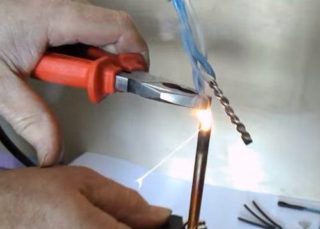
The SIP conductor is broken and connected to the VVGng cable by twisting and strengthening by soldering.The technique is not reliable, as it can lead to fires.
Connection of various conductors with fittings
SIP and VVGng are connected using standard reinforcing rods, piercing clamps or other elements near the entry point. It is unacceptable to use a self-supporting insulated wire in a residential area - it supports combustion processes.
Through difavtomat
The connection diagram provides for the use of a two- or four-pole differential circuit breaker. The device is located in a separate sealed box. The cable is laid from the main line to the box, connected to VVGng in a corrugation.
To increase protection, an automatic machine with a rating higher than the switchboard is used. So in case of a short circuit or overload, you can restore the line without leaving the house. Outside, another device is installed to de-energize the internal cable and prevent a fire.
Electric lines can be entered into a residential building by air or underground. Before starting work, it is necessary to issue permits, select an SIP cable and its cross section.

